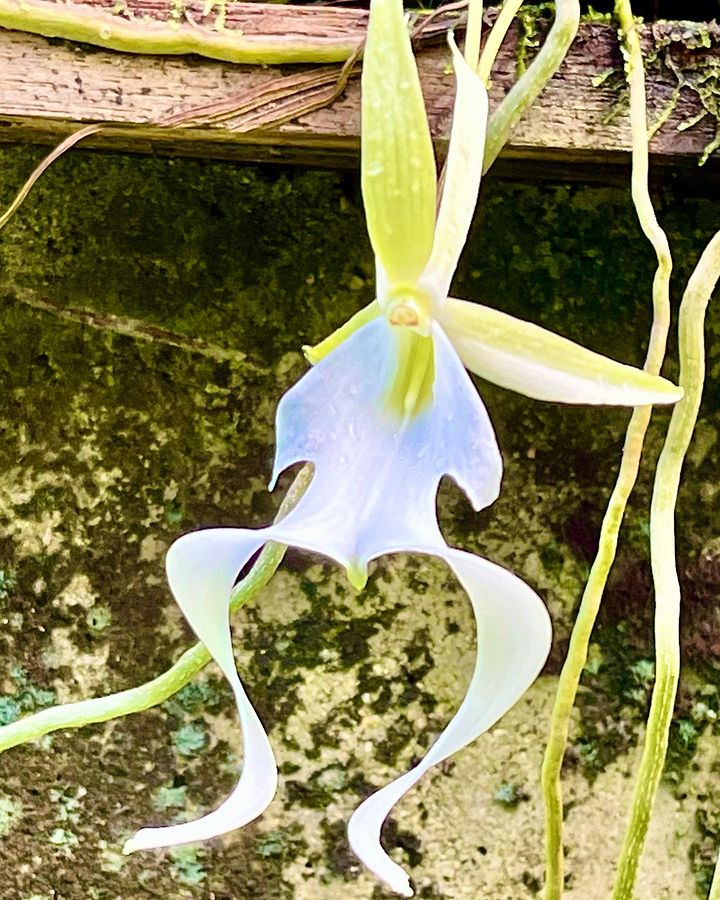To survive in harsh environments, some special plants, like the Omkara flower, rely on the roots and prepare food through photosynthesis.
The Omkara flower, also known as the Ghost Orchid, blooms from spring to summer. The white blossoms look like a ghost due to the eyes-like structure of the flower.
So, go through this article to know every detail about the amazing Omkara flower, its pollination, and how to pollinate it.
Table of Contents Show
What does Omkara Flower Look Like?
The Omkara flower (Dendrophylax lindenii) is a rare flower with white petals and a sweet, refreshing fragrance.
Basically, this plant is a parasite that gets its nutrients from the host tree’s dead particles where it is growing. It’s because the plant does not contain any leaves.
Omkara flower is native to Florida, the Bahamas, and Cuba and grows well in moist swamp forests with a wetland.

Although the plant has no leaves, photosynthesis occurs from its green roots that prepare food and supply the whole plant.
Moreover, a 2-foot-long slender stem supports the flower that reaches about 2 inches long. The flower also contains nectar in the spur.
On a closer look, you can see two small leaves-like structures called bracts. These are the green parts that enclose the flowers when young to protect them.
Furthermore, the flower also contains two long tendrils. The tendrils swing downwards on the lowermost petals.
Is Omkara Flower Illegal to Grow?
The Omkara flower is a real flower that is rarely available due to the complex growing conditions.
Furthermore, changes in climate, illegal collection, and habitat loss make this plant rare and endangered in its native range.
Thus, this plant is available in limited areas, but if it gets a suitable environment, your garden can change to a whole new level.
The white or cream-white flowers look just like flying butterflies. The flowers also look like they are floating in the air.
Moreover, the name Omkara is because of the unique shape of the flower that looks just like a sacred sign of Hinduism.
Make sure to grow this orchid on 70 to 80% humidity and indirect light. Imperfect growing conditions can cause its flowers to fall and stems to turn red.
Additionally, use a mister to maintain humidity and sheer curtains if you want to place it in a window that receives direct sunlight.
Omkara Flower Pollination
Due to the complex flower structure, pollination is complicated in the Omkara flower as the nectar lies in an unreachable area.
To feed on the nectar, the pollinator must have a mouth structure that perfectly fits the flower structure.
Thus, the pollinators of this flower are limited.
Omkara flower only undergoes pollination if the mouth of the pollinator reaches the pollen and transfers it to another flower.
Basically, Omkara flowers are pollinated by insects and birds with long proboscis-like Hawkmoth, Hummingbirds, etc.
During the shortage of pollinators, you can also hand pollinate the flowers, but there is very little chance of success.
To hand pollinate this amazing flower, take a long tweezer and gently pick out the pollens without damaging them.
Usually, it is very difficult to pollinate the Ghost Orchid, even with the help of moths. Moreover, the flowers open only for a small time period.
From Editorial Team
More About Omkara Flowers!
While hand-pollinating the Ghost Orchid, remember to start the process in the early morning, as the pollens are mostly active in the morning.
Moreover, it may take several years for this plant to bloom. Thus, keep patient and maintain the optimal conditions if you are into adding this beauty to your garden.
